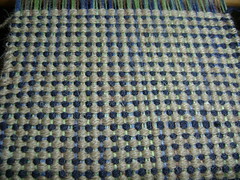
By Amelia
There are plenty of nice Rigid Heddle books out there. I've heard terrific things about Betty Linn Davenport's Hands on Rigid Heddle Weaving
and the revised Ashford Book of Rigid Heddle Weaving (the revised edition with a male on the cover, not the original with a female on the cover) -- my copies will get here soon, I hope!
In the meantime, I am consoling myself with the excellent Textures and Patterns for the Rigid Heddle Loom
So, how many patterns in The Handweaver's Pattern Directory: Over 600 Weaves for 4-shaft Looms
p. 29, simple tabby (hey, you gotta start somewhere), warp 1 color, weft another.
p. 30-31, tabbies in a variety of colors -- 6 interesting combos with 1 warp color and 1-2 weft colors (sometimes using the warp color, sometimes not).
 p. 46-47, hopsack -- very interesting way to make a nice sturdy (thick) fabric. The 2-2 hopsack could be done with doubled yarns in the heddles & slots. Three nice color combinations shown for each, of two different warpings, so six total. (Picture is Deb's hopsack, in progress on her 2H loom)
p. 46-47, hopsack -- very interesting way to make a nice sturdy (thick) fabric. The 2-2 hopsack could be done with doubled yarns in the heddles & slots. Three nice color combinations shown for each, of two different warpings, so six total. (Picture is Deb's hopsack, in progress on her 2H loom)p. 48-49, tabby with two-color warps. Simple alternating color warps and a variety of weft color uses lead to interesting stripes of color, from log cabin to fancy Aztec-looking things (they look Aztecy to me, that is). Six total shown.
 p. 50-51, tabby with two-color warps, a variety of threadings from the cool herringbone check to larger checks that look like way too much fun! DD is working on the smallest check in a scarf for her teacher. Three warps and 3 wefts for a total of 9 combinations.
p. 50-51, tabby with two-color warps, a variety of threadings from the cool herringbone check to larger checks that look like way too much fun! DD is working on the smallest check in a scarf for her teacher. Three warps and 3 wefts for a total of 9 combinations.p. 60-61, Hopsack: two-color warp. Oooh, aahh -- three warps times three wefts equals nine more ways to stripe and get fun color patterns. And you know what -- you can vary the warp across the loom, and the weft as you weave a piece to have panels of different checks and stripes. The mind boggles.
p. 154-155, Hand-manipulated wrappings, 6 interesting combinations of wrap and color.
p. 156-157, Brooks Bouquet (hand-manipulated), 3 varieties fo this technique for different effects.
p. 158-159, Danish Medallions (hand-manipulated), now these intrigue me and are on my short list -- three varieties shown here, I've seen others in other books too that are worth exploring...
p. 194, Crammed and Spaced: straight draft. This is all the rage in warp and weft right now for weaving and felting scarves. Simple to do on a rigid heddle with gorgeous results!
p. 230-231, Warp Face: three great striping effects with color combinations in warp and yarn thickness in weft.
p. 232-234, Warp Face: Rep; Two Color. This style of weaving intrigues me. I'm not sure if the rigid heddle can do heavy fabrics like this makes, but I'm curious to give it a try. Two of the Rep Weaves are simple 2-heddle patterns, so there may be a way to thread the rigid heddle to get this effect.
p. 238, Twining, Loops, and Soumak -- all on a plain weave tie-up, so these look pretty do-able, if you want to explore these three techniques. Three loops shown, so a total of 5 things to try here.
p. 239, Inlay -- on a plain-weave tie-up, looks like an interesting way to add a picture into a plain weave.
Did I miss one? Let me know! These are 61 potential rigid heddle jumping-into points -- about 10% of the book overall. Not bad, eh.
I notice the book didn't get into plain weave and color for plaid effects at all, but then again whole books have been devoted just to Scottish Tartans -- Harriet Tidball's Weavers Book of Scottish Tartans (Shuttle Craft Monograph)

The Anne Dixon book also has some terrific 1/2 and 2/1 twill patterns in it, which I'm currently exploring with my 2-harness Emilia loom (pictures to follow...)
~~
Do you have a book of patterns you turn to for Rigid Heddle ideas? Let me know, I'm on the hunt for more. My potential project queue may even be larger than my stash but luckily it takes up alot less space (grin!)
~~
posted 3 January 2009 at http://askthebellwether.blogspot.com/
